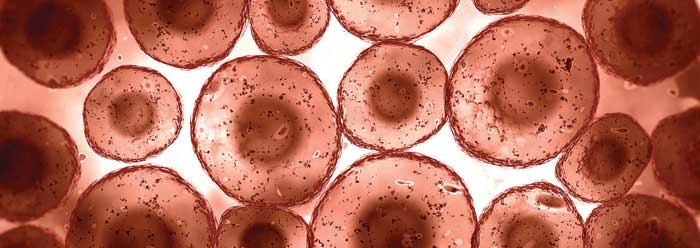God has created man with 100 trillion cells, each of which is a wonder of microminiaturization. The biochemical processes that occur moment by moment are nothing less than astounding. The bewildering complexity of these tiny functional units was acknowledged even before recent discoveries of how cells operate at the nanotechnological level.
If you could build a motor one millionth of a millimetre across, you could fit a billion billion of them on a teaspoon. It seems incredible, but biological systems already use molecular motors on this scale.1
Indeed, "it seems incredible" to suggest that such sophistication is the result of chance, time, and genetic mistakes!
A 1997 Nature article by Steven Block detailed the "Real engines of creation" that included a discussion of sub-cellular structures composed of springs, rotary joints, and levers--all made of protein.2 The awareness of cellular sophistication has only increased by orders of magnitude since then, further demolishing the increasingly anemic Darwinian explanations for the origin of cells.
The cell or plasma membrane surrounding each cell has been called living because of its extremely precise selectivity--allowing or actively pumping some materials in or out, but not others. Complicated but efficient protein molecules "float" in the midst of this bilipid membrane. Some extend halfway and others all the way through the two interconnected membrane layers.
For the cell to remain alive, there must also be a constant exchange of materials from the outside of the cell to the inside, and vice versa. For example, among many other ions, potassium is critical for cellular function and homeostasis.3 A precisely shaped and charged potassium gate found in the cell membrane is known to have a latch that rotates much like an iris! It also has switches and pulleys.4 Working in exquisite harmony, the four principal parts of the gate--collectively called the Kir channel--are designed to selectively allow millions of potassium ions per second to pass through the gate while keeping out legions of pesky gatecrashers (other ions).
Cellular machines are not the stuff of randomness, but reveal unparalleled sophistication emanating from the mind of the wise Creator. Consider this quote describing the transfer of an electron to a heme portion of a ubiquitous protein involved in ATP (energy) production in living systems:
This [electron] loading increases the redox potentials of both hemes a and a3, which allows electron equilibration between them at the same rate. Then, in 0.8 milliseconds, another proton is transferred from the inside to the heme a3/CuB center, and the electron is transferred to CuB. Finally, in 2.6 millisesconds, the preloaded proton is released from the pump site to the opposite side of the membrane.5
Is it logical to attribute such overwhelmingly complicated machinery to genetic mistakes "guided" by natural6 happenstance? No. Cellular research increasingly unveils amazing discoveries that should cause Darwinists to consider Paul's proclamation to the church in Rome: "For the invisible things of him from the creation of the world are clearly seen, being understood by the things that are made, even his eternal power and Godhead; so that they are without excuse" (Romans 1:20).
Sadly, for many biologists it doesn't matter what the burgeoning evidence shows. Those with a secular worldview must avoid pursuing the obvious design implication and therefore give glory to the creation7 instead of the Creator to whom it is due.
References
- Feringa, B. L. 2000. Nanotechnology: In control of molecular motion. Nature. 408 (6809): 151-154.
- Block, S. M. 1997. Real engines of creation. Nature. 386 (6622): 217-219.
- Dubyak, G. R. 2004. Ion homeostasis, channels, and transporters. Advances in Physiology Education. 28 (4): 143-154.
- Clark, et al. 2010. Domain Reorientation and Rotation of an Intracellular Assembly Regulate Conduction in Kir Potassium Channels. Cell. 141 (6): 1018-1029.
- Belevich, I. et al. 2007. Exploring the proton pump mechanism of cytochrome c oxidase in real time. Proceedings of the National Academy of Sciences. 104 (8): 2685-2690.
- Guliuzza, R. Natural Selection Is Not 'Nature's Design Process'. Acts & Facts. 39 (4): 10-11.
- Futuyma, D. & M. Kirkpatrick. 2017. Evolution 4th edition. Sinauer. 93.
* Dr. Sherwin (D.Sc. Hon) is news writer and senior science lecturer at the Institute for Creation Research.
Cite this article: Sherwin, F. 2010. Cells: Sophisticated and God-Designed. Acts & Facts. 39 (8): 17.









